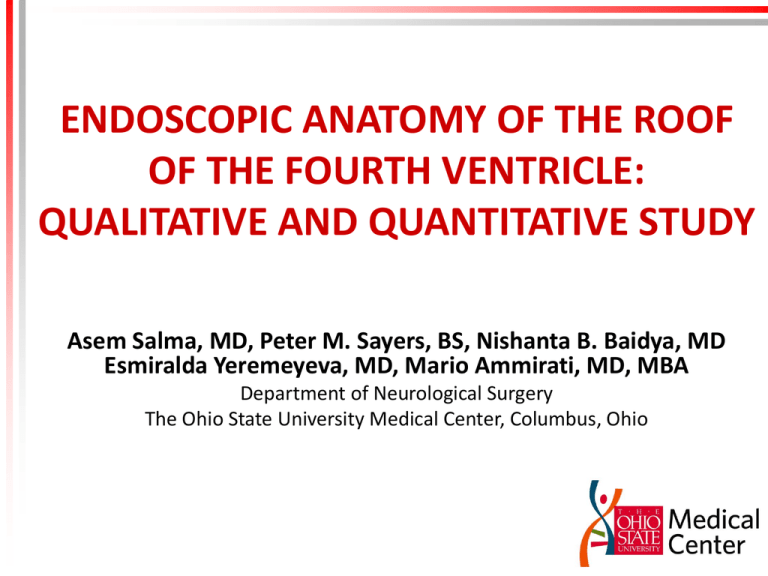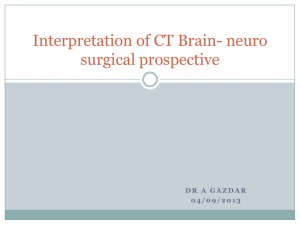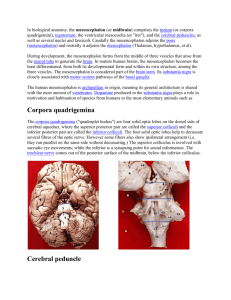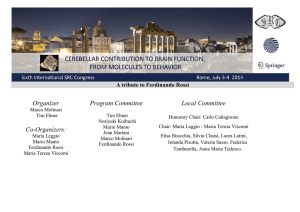Endoscopic Anatomy of the roof of the fourth
advertisement

ENDOSCOPIC ANATOMY OF THE ROOF OF THE FOURTH VENTRICLE: QUALITATIVE AND QUANTITATIVE STUDY Asem Salma, MD, Peter M. Sayers, BS, Nishanta B. Baidya, MD Esmiralda Yeremeyeva, MD, Mario Ammirati, MD, MBA Department of Neurological Surgery The Ohio State University Medical Center, Columbus, Ohio Disclosures • Nothing to disclose Background and Objective • The anatomy of the roof of the IV ventricle has received less attention compared to its floor, and has rarely been thoroughly discussed in the neurosurgical literature. • As the use of the endoscope is becoming more popular as an adjunct to microsurgical techniques we conducted an anatomical investigation of the endoscopic appearance of the roof of the IV ventricle to demonstrate its endoscopic features Materials & Methods • We explored the IV ventricle in 8 cadaveric heads by using 2.7 mm and 4 mm (0 degree and 30 degree angles) rigid endoscopes. The endoscopic anatomical features of the IV ventricle were extensively studied and documented using imaging capture and recording. • In addition we made 7 casts of the IV ventricle and measured the caudal diameter of the aqueduct, the length of the superior cerebellar peduncles and the distance between the farthest separations of these two peduncles Results Qualitative Analysis General overview • The roof the IV ventricle can be looked at as an anatomical complex structure with unique geometrical configuration. It consists of lateral portions which form bilateral pillars for the midline portion (the medullary vela). The lateral portion is formed by the cerebellar peduncles (superior, inferior and middle), and the midline portion is formed by the superior and inferior medullary velum. • The roof can be divided into three zones; the upper, middle and inferior, and every zone corresponds to a specific lobe of the cerebellum. • The upper zone is associated with the anterior lobe of the cerebellum. Here the roof is formed by the superior cerebellar peduncles as the lateral component and an intervening bridge (superior medullar velum) in between the two superior peduncles across the midline. In the uppermost part the superior cerebellar peduncles converge toward the midline. Figure A, the upper zone. Endoscopic view of the roof of the IV ventricle. Superior cerebellar peduncles (SP); superior medullary velum (SMV); cerebral aqueduct (Aq). • The middle zone is associated with the posterior cerebellar lobe. Here the roof is represented by the inferior cerebellar peduncles as the lateral component and the inferior medullary velum as the midline component which creates an intervening bridge in between the two inferior peduncles. Figure B, the middle zone. Endoscopic view of the roof of the IV ventricle. Superior cerebellar peduncles (SP); superior medullary velum (SMV); inferior medullary velum (IMV); inferior cerebellar peduncle (IP). • The lower zone is associated with the flocculonodular lobe. Here the roof consists of the tela choroidea and choroid plexus. In this region, the tela choroidea creates both the midline component and the lateral components, as the arrangement of the cerebellar peduncles changes from their lateral orientation into an anterolateral orientation. The tela choroidea extends from the inferior peduncle (anteromedial) and the middle peduncle (anterolateral) posteriorly and downward to reach the taenia of the IV ventricle. Figure C, the lower zone. Endoscopic view of the lower zone of the roof of the fourth ventricle. Superior cerebellar peduncles (SP); inferior cerebellar peduncle (IP); lateral recess (LR). The right view shows the lowermost part of this zone. Quantitative Analysis • We made 7 silicone casts of the IV ventricle and took the measurement as shown in Table 1. However we were unable to get the casts of the lower portion of the roof because the casts that filled the crevices of the tela choroidea and choroid plexus were very fragile and hence that would easily give away whenever we would try recover the casts from inside the ventricle. Anatomical Landmarks Minimum Mean ± SD Maximum Median Diameter of the Aqueduct 2.78 ± 0.47 3.5 3.0 2.0 Superior Cerebellar Peduncle 25.92 ± 0.78 27.0 26.0 25.0 Distance between the farthest distal ends of the superior cerebellar peduncles (width of the fastigium) 17.78 ± 0.84 19.0 18.0 16.5 Table 1. The table shows the mean values ± standard deviation (SD) of different anatomical landmarks of the seven IV ventricle silicone casts with the maximum, minimum and median values for those landmarks. All measurements are in mm. Conclusions • Having a through knowledge of the endoscopic anatomical characteristics of the roof of the fourth ventricle may be helpful in purely endoscopic or endoscopic assisted approaches to the IV ventricle.











